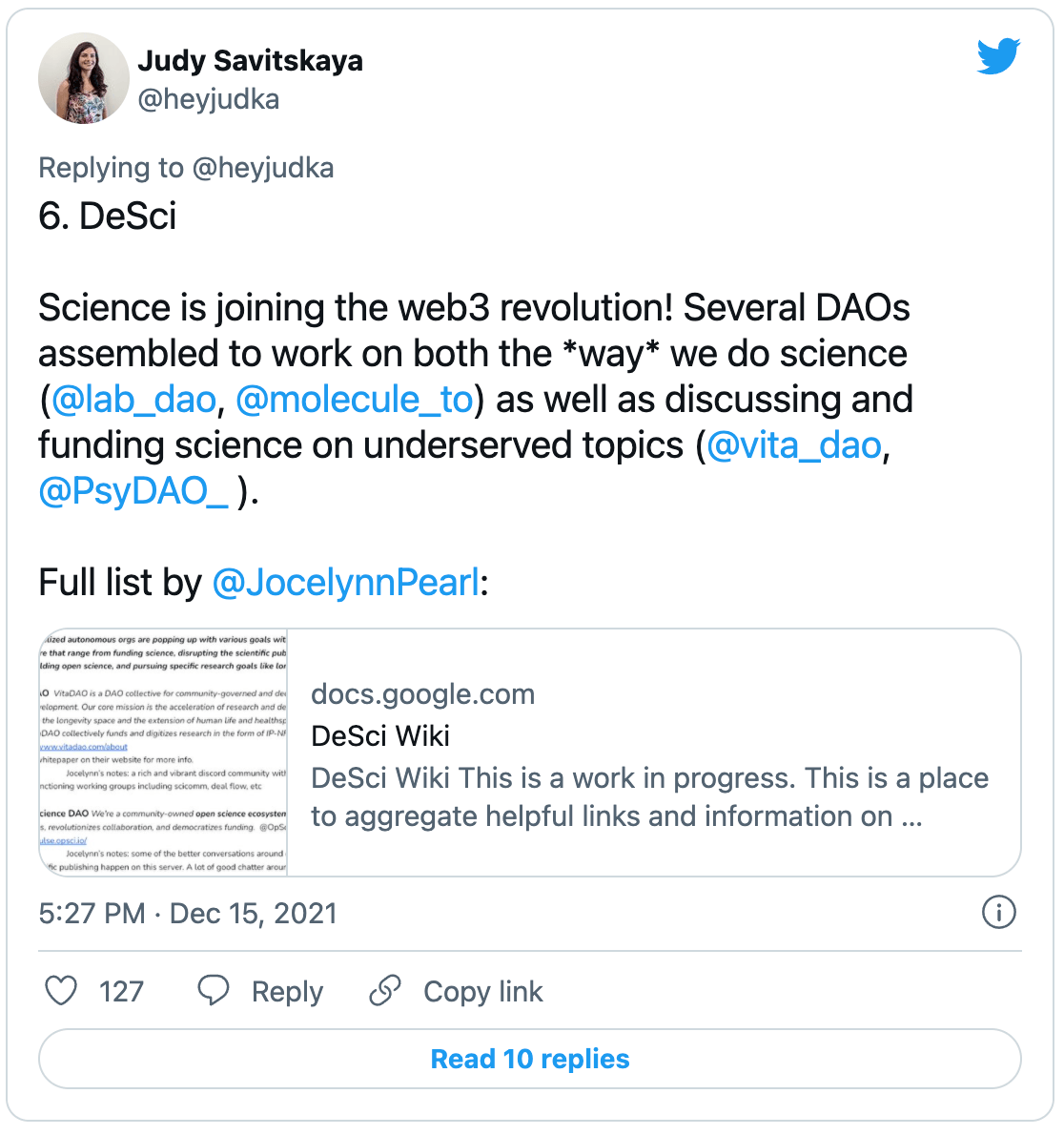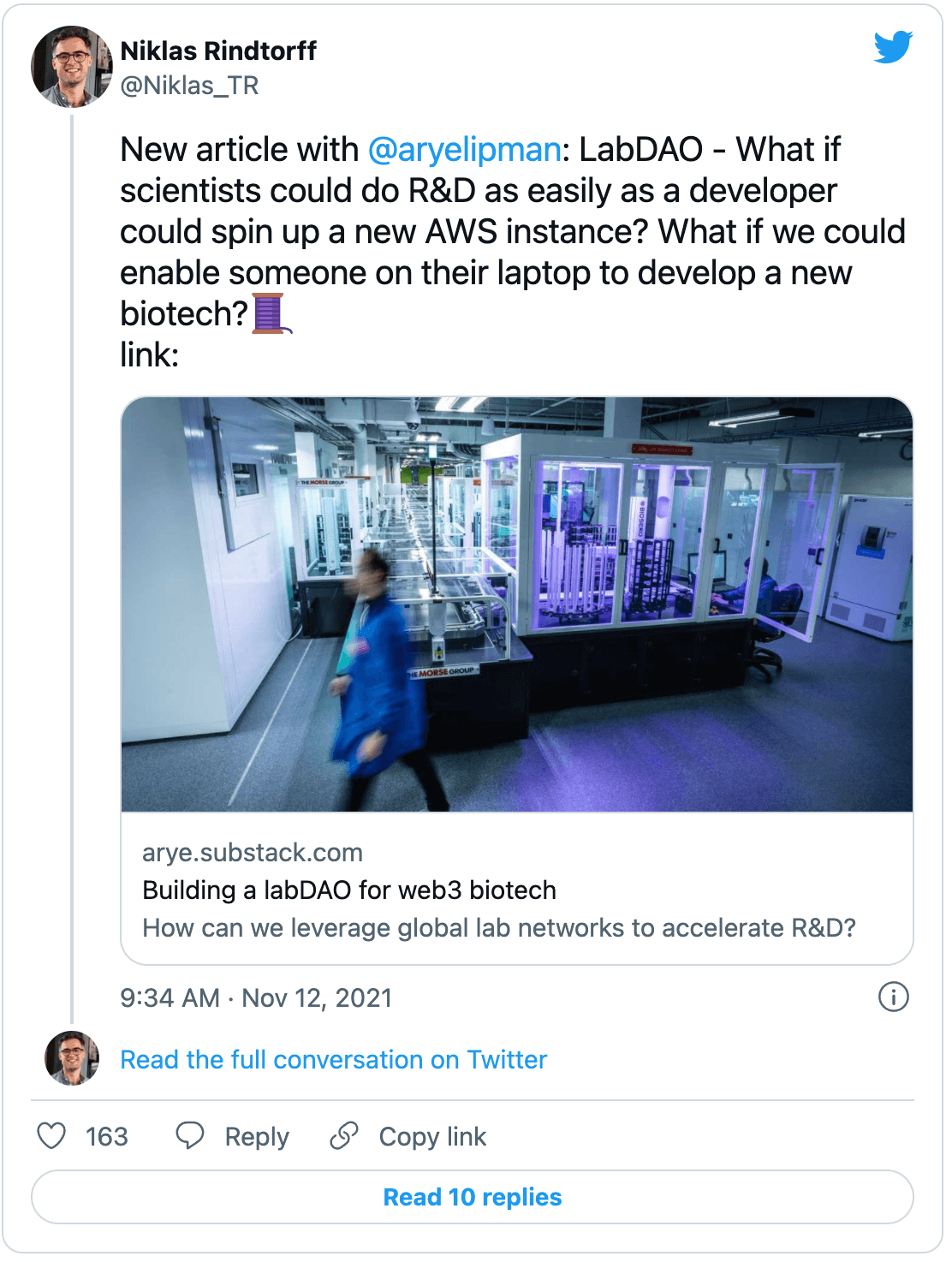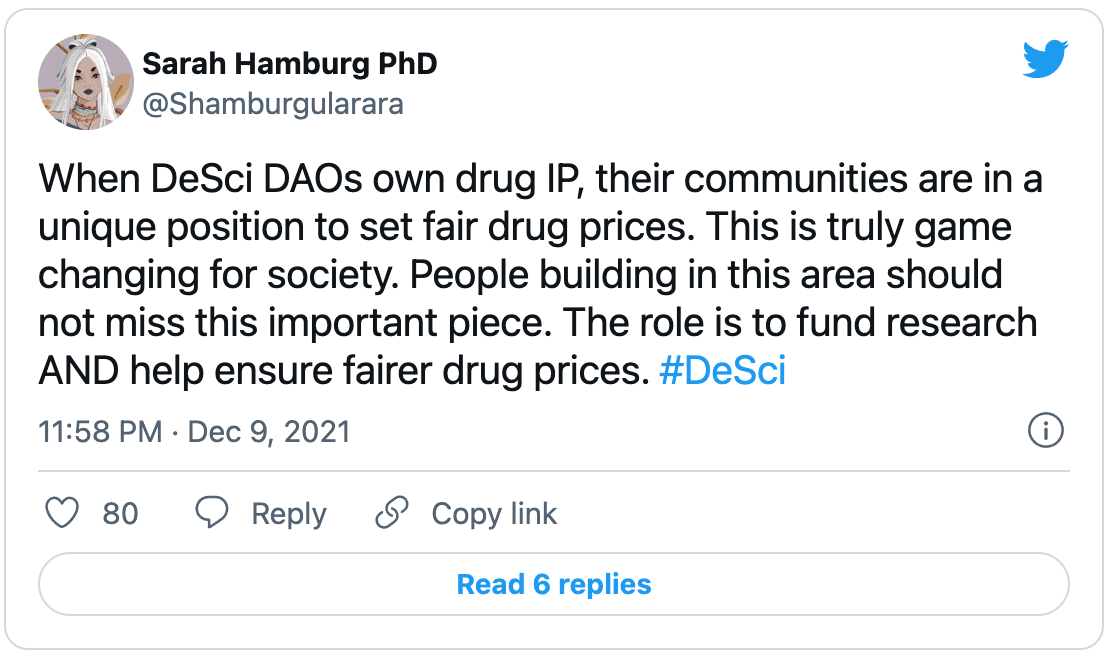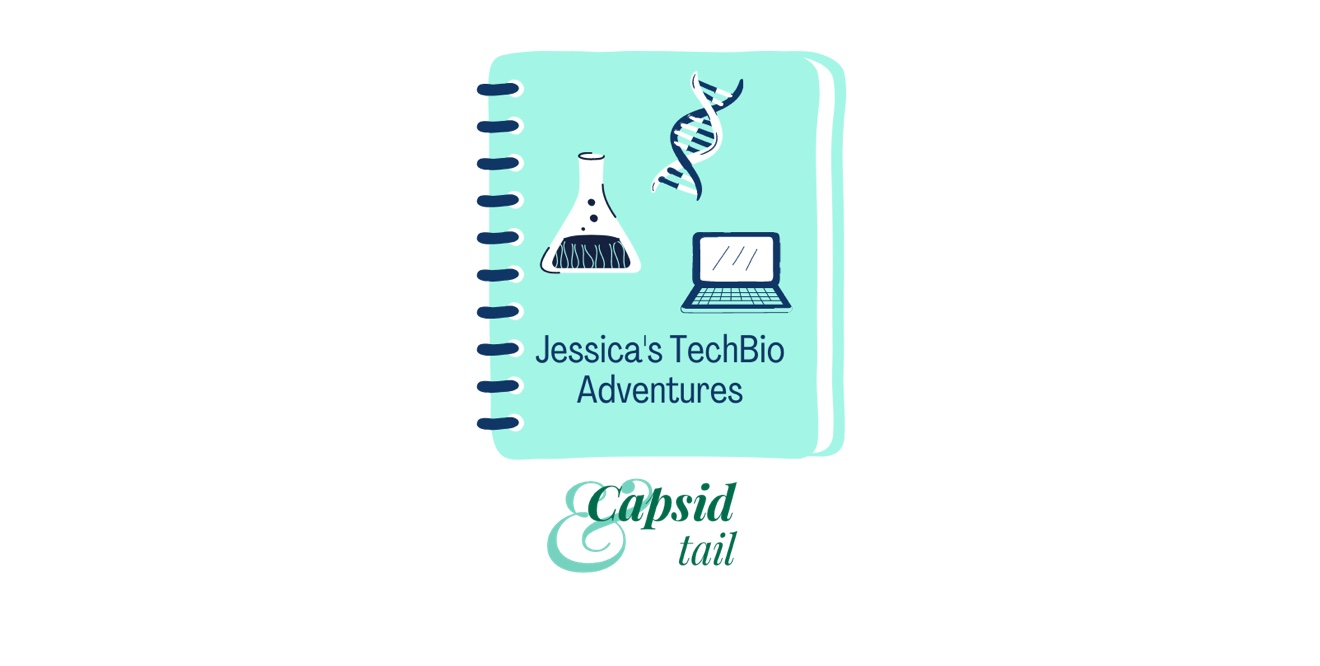This post originally appeared here in Jessica’s TechBio Adventures on January 16, 2022.
Scientist friends, it’s time we got up speed on Web3 so we can help bring this revolution to science, biology, and biotech.
TL;DR: Web3 is about WAY more than just Bitcoin and buying/selling jpegs online. It is probably the next revolution of our time (for most industries). And yet for once, science and biotech are not being left until last! Web3 brings both the power and the will to meaningfully shake up age-old problems in science and biotech, and it’s massively picking up lately. So you might as well dive into it with me now!
Thanks so much for being here for post #2 of Jessica’s TechBio Adventures! (Subscribe to get future posts here)
Launching this blog a couple weeks ago was a big leap for me, so it’s been really nice to see the words of encouragement that have come in!
Today I wanted to talk about Web3 and what it could mean for science and biotech. Web3 is a new era of the internet that is bringing together new tech + an influx of the best kind of people: talented, optimistic builders who like to share. And Web3Bio is made up of people like this who also care about working on science/biology/biotech problems. (Unicorns, basically 🦄).
The Web3Bio (also known as DeSci/DeBi; for now I’m using all these interchangeably) world is very new, but already off to a racing start. Already there are several Web3Bio organizations getting to work, like VitaDAO, LabDAO, Molecule, Opscientia, PsyDAO, and SCINET. (Jan and I are even thinking Phage Directory could fit into this group with a few tweaks). And by definition, Web3Bio is open for us all to pitch in and join the movement. (Yes, that means us too, fellow scientists, even if we’re new to the tech world).

P.S. There are TONS of other places to learn about Web3; this is just how I’m wrapping my head around it as a scientist who recently immigrated to the tech world.
If you want to dive more into the Web3 world, from people who know way more than me, I suggest starting with:
What is Web3, and why does it matter to science?
You may have heard of Web3 — the ‘third era of the internet’. Or maybe not! I hadn’t until very recently, but as I got into in my last post, Tech + Biology = Great possibilities, when you hang out with ‘tech people’ (you only need one!) you get to hear about these things.
Web3 is an umbrella encompassing many terms you may have seen floating around lately, like crypto, NFTs, blockchain, the metaverse, DAOs, DeFi, tokens, decentralization… (it’s an entire world of scary-seeming lingo, I know).
At first, I figured that stuff wasn’t for me. I’d let Jan (my cofounder/partner) and the other ‘computer people’ get into that, build us a metaverse, etc. I’d hang out in it once it’s built. In the meantime, I’d be over here working on science and biotech. But the more I’ve started to learn about Web3, the more I’ve become convinced that this new era/universe is a big deal! It represents a rapidly expanding abundance of new tools (new superpowers for computer people) and an influx of really smart, cool, innovative, committed, generous people. I think this stellar combination could help solve problems that have been facing science and biology for decades.
Science and biotech are inefficient, which means scientists waste a lot of time and people die
It’s no secret that scientific funding, publishing, and translation of scientific results into real-world impact is woefully inefficient compared to what it could be.
I think of three main problem areas:
-
Funding: who gets funds to do research? What gets funded? What doesn’t?
-
Knowledge dissemination: how is research shared / made available? How much is shared?
-
Intellectual property (IP) and research translation: who owns the fruits of research, and how is it leveraged to solve real problems in the world?
While there’s a lot that works about all three, there are big issues with each, and they run deep. Like many things (maybe everything?), it’s the way it is because of the incentive systems currently in place.
If you’re not well-versed in how scientific research works and the economic systems/incentives that drive it, or if you want to see it all concisely laid out, I highly recommend this article, Magna Carta Scientiae, by @atoms_org. I also recommend this post, How Life Sciences Actually Work: Findings of a Year-Long Investigation, by Alexey Guzey, founder of New Science.
Our age-old problems in science are fixable
I feel like many of us scientists have tended to think these issues with research funding, knowledge dissemination, and translation would probably never be solved (or not in our lifetime).
I for one have been mad/perplexed about the way things work in science for almost a decade, starting soon after I started in the lab in 2010. I’ve been told time and again that that’s our system, deal with it if you want to do science. It was disheartening to learn about how publishing and funding works, how much time playing those games takes out of a scientist’s day, how much it all dictates what happens in the lab. Not to mention how little scientists/science are actually valued, even though this work and the people who do it underpin such an important part of society’s foundation.
As I talked about in my last post, the more time I spend with people in the tech/startup space, the more I’m realizing that science’s problems come from manmade systems of incentives, not from fundamental truths of the universe. I’ve learned that, luckily for us, the status quo can be redesigned without needing to convince arbiters of the current system to change. (See Airbnb not getting permission from hotels to revolutionize traveling).
As I’m learning, what it often takes to shift systems (even big, entrenched ones like we see in science) is a combination of new incentives, some outside perspective, a conscious effort to adapt and mash-up ideas and methods that have worked in other industries, and a ‘how can we make this work’ attitude. This may be obvious to people already steeped in the tech/startups space, but it was not obvious to me as a biologist.
Web3: a new era, where innovation of all kinds will get easier
Thanks to explainers all over the internet, but especially Packy McCormick’s Not Boring blog, the simple way I now think of it is:
-
Web1 was the era of the internet that started back in the 90s (this brought us things like email and ‘http’, which lets us all see and use websites).
-
Web2 is the internet most of us are familiar with nowadays (think Facebook, Google, etc).
-
Web3 is this new era starting basically right now.
Web3 builds on the foundation of Web1 and Web2, in a sense taking the best of both worlds. It’s is a special combination of the openness/sharing practices of Web1, the modern tools and technologies brought about by Web2, and the existence and growing adoption of the blockchain.
In this next section I’ll try to explain how this combination leads to some really cool new ways of enabling and incentivizing people to get work done (together). While this can (and will) be useful for any industry, I think science and biotech needs this very badly, and society will benefit in a big way if we can make this happen.
How Web3 superpowers our ability to get things done (together)
TL;DR: Thanks to the blockchain, which is Web3’s foundation, in Web3 people can own things they help build on the internet. This means if you have a project, it’s easier to incentivize people to work with you, and if you have expertise, it’s easier to get compensated for sharing it. And most importantly, the ethos of Web3 (like the open source software movement) is to share what is built as building blocks for the next person, so everyone can riff off of what each other is doing, and make something even better, faster. (Like jazz meets compounding interest!) 🎺 📈
Web3 enables people to own what they help build on the internet
One big distinction between Webs 1, 2 and 3 relates to ownership. With Web1, most everything was open and shared; no one really owned it. In Web2, companies like Facebook have owned/profited from most of it. With Web3, theoretically anyone can own things on the internet and make money when they help build things on the internet. (More on this)
But how? This is in part because of blockchain technologies that Web3 is built on…
The blockchain helps us trust each other on the internet (or lets us work together even if we don’t)
The blockchain is an open public register (a ‘decentralized ledger’) that keeps track of things, such as transactions (buying/selling), contracts and more. All without the need of a trusted party to enforce it all. (This clearly goes way beyond Bitcoin! For example, learn about what the Ethereum blockchain can do/enable here).
🎨 One small example: If a piece of art were put on the blockchain, every time it’s sold to someone new, its creator could automatically get a cut of those future transactions in perpetuity (this arrangement would be built into the code and permanently linked to that piece of art).
For science, the first thing that comes to mind is what that could mean for a scientist who makes a discovery and registers it on the blockchain — could that scientist make a percentage of everything that comes of that discovery?
Web3 makes it easier for groups of people to coordinate, do work, make and allocate money together
Taking this concept of ownership a step further, what if you could own part of a company you helped build part-time on the internet? Web3 is enabling new types of organizations called DAOs to form, where many people can contribute to a project online, and earn part ownership in whatever comes of that project. Maybe it’s a company that sells products, maybe it’s a collective that invests together — it could be anything! With a wallet (essentially a bank account on the blockchain) that can be operated securely by multiple people, a group of members can vote on what happens to a co-owned pot of money, decide on strategy, and more.
Web3 tech makes it easier to incentivize work
Web3 tech makes it easier to compensate people for contributions using equity, not just cash, no matter where they live or how much time they can spare. This means anyone with an idea can incentivize the best people to help, even at the idea stage. People don’t have to leave their jobs to start contributing their expertise to a project they care about. This unlocks more of world’s expertise for even new/small projects, as long as the mission is attractive.
Of course, there’s lots about science that could benefit from this, since so many ideas never make it to the point of being fundable by current systems. (More on this in future posts).
A ‘build-share-repeat’ mentality means compounding progress
The underlying tech infrastructure is a big part of why Web3 is powerful, but this alone wouldn’t be enough. It’s not just the tools that matter, it is also the people and how they use them.
Web3 is being built by thousands of people and organizations at once. Fortunately for us all, it’s being built by people who share what they’re doing freely on the internet, so anyone can adopt their ideas/systems, and use them as building blocks to make other/better things. Packy McCormick calls this phenomenon ‘Idea Legos’.
In principle this is how science has operated for a long time, or at least this is the idealistic version of what it’s supposed to be (rumour has it that Jan is planning a post on how science is one of the original decentralized systems, can’t wait to read that!)
What if we focused the power of Web3 on science?
Once you think about it, it’s easy to see how Web3 will likely be revolutionary for countless industries. It’s generic like the internet — it’s a spotlight that can be pointed at anything. And it’s not theoretical, it’s happening. Projects are being started left and right, and everyone’s excited to get involved. The question now is, what to build?
What could we make happen if we aimed Web3 tech/people/ethos at science/biology/biotech’s problems?
There are at least three main areas I’m really excited about, and there are already vibrant Web3 organizations/communities working on each. For now, a brief overview:
1. What happens when Web3 meets lab work (doing experiments, sharing reagents, bioinformatics analyses)?
- E.g. LabDAO is building an open, community-run network of biological laboratories (I’m excited to have jumped into helping out with LabDAO; more on this in future posts!)

2. What happens when Web3 meets biotech (biotech, intellectual property ownership and technology transfer, and drug development)?
- E.g. Molecule is working on ‘IP-NFTs’ to put biotech IP on the blockchain and enable ‘fractionalized ownership’ (think the stock market, but for research discoveries)
3. What happens when Web3 meets science (research funding, academic publishing, peer review, citations, storing and sharing data, reproducibility)?
- E.g. VitaDAO is funding longevity research and has already funded two research labs’ projects (and minted two IP-NFTs using Molecule’s system, which means VitaDAO owners will own what comes of this research, and will collectively govern what happens with it)

- E.g. Opscientia (OpSci) is making open science research workflows findable, accessible, interoperable and repeatable (I’ve also started dabbling in what OpSci is doing, and am excited to find ways to help out!)
In future posts, I’ll go deeper into the groups tackling these areas. I’ll also share insights from the Web3Bio organizations/projects I jump into.
In the meantime, check out Jocelynn Pearl’s DeSci Wiki for a giant list of Web3 science and biology initiatives. (Maybe you’ll find one or two to join, or maybe you can add something to this growing resource!)
Let’s make Web3Bio happen!
In summary, science and biotech are rife with inefficiencies that most of us scientists thought we’d never solve. Luckily, in Web3, a ton of innovation is happening that is enabling people to start and organize new efforts, get compensated, and amplify their impact by contributing to a system that is designed to build on itself.
Web3’s combination of powerful new tech + people with a build-share-repeat mindset is going to be powerful. This could revolutionize any industry, but I for one want to make sure science and biotech doesn’t miss this wave.
Miraculously, a lot of these optimistic-builders-who-share are starting to see science and biotech’s problems as worth solving, and are choosing to focus their newfound Web3 superpowers in this direction. Having been on the receiving end of this phenomenon with Phage Directory (when a random encounter with a single one of these kinds of people (🦄) transformed my research impact from a low-impact virology article every other year to saving the lives and limbs of actual human beings), I am here to tell you this is a Very Good Thing!
Importantly, we scientists are needed to help the builders ground themselves in what our field really needs, and what the issues and intricacies are. We need to be actively joining these projects and helping them grow. We do not need to ‘leave science’ to do this. There are so many issues, and they are big, but there are so many of us too. And I know for a fact most of us thought we’d be having more impact by now. Well, now we have our chance!
In other words: fellow scientists, they need us in the new world; let’s join the fray and see what we can do together! 👩🔬
See you all next time, thanks so much for being here!
— Jessica










